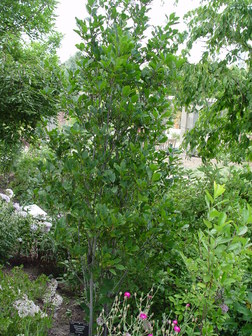Back to Tour: Medicinal Plants Tour
|
Aronia arbutifolia 'Brilliantissima' Brilliant Red Chokeberry Aronia arbutifolia 'Brilliantissima' Brilliant 830947*3 is no longer in the Denver Botanic Gardens plant collection. |
Denver Botanic Gardens
Gardens Navigator 
|
|
Accession Number: 830947*3 Map | |
| More about Aronia arbutifolia 'Brilliantissima' Brilliant | |
| TOUR DETAILS |
Medicinal uses: The fruits of the chokeberry are the most used part of the plant, as they have high antioxidant properties, even higher than elderberry! The berries are also rich in pectin, which is known to protect the body from radiation as well. Due to the high antioxidant properties of chokeberry, the plant is recommended as a natural supplement in treating certain cancers, cardiovascular diseases, and chronic inflammations. Mythology/Folklore: Unlike its common name, the berries of Aronia artbutifolia will not make you choke. The plant gets its name because the berries are practically inedible when raw and highly astringent (dries out oily skin). Chokeberries were highly used by Native American tribes. The Wampanoags were known to use berries both fresh as well as dried during winter-time. The Potawatomi people used the fruits also as food. They additionally made infusions from the fruits to treat their cold symptoms. Chokeberries are commonly found in swampy areas and are deciduous (dropping their leaves in the fall). The brilliant red chokeberry we have here at the Gardens has hairs on the underside of its leaves. The plant is used as food for white-tailed deer, rabbits, ruffed grouse, sharp-tailed grouse, and prairie chickens. Medicinal recipe: Chokeberry Syrup Heat just enough water in a saucepan to get a simmer going. Crush the added chokeberries gently as they cook in the water. Add sugar to taste. Let the sugar melt and the juice seep out of the fruit. Strain, then cool. Refrigerate the syrup or freeze it to make it last longer. Combine with vodka or eau-de-vie to taste for a delicious cocktail. Culture: (from Sonya Anderson, staff horticulturalist) “In my experience the chokeberry does well in partial shade with a medium amount of moisture here in Colorado. I have one in full shade that is not as vigorous-it has not grown as much, is weak looking with fewer leaves and little to no fruit. The one in partial shade with medium moisture is growing well, and flowering and fruiting better and better every year.” |
| LOCATION GROUP | Birds & Bees |
| FAMILY NAME | Rose Family |
| FAMILY | Rosaceae |
| ACCESSION DATE |
March 18, 1983 (When this plant was acquired and registered in the database) |
| DATE LAST MEASURED | January 27, 2003 |
| HEIGHT (FEET) | 6 |
| SPREAD (FEET) | 1.5 |
| FLOWER COLOR | yellow |
| HABIT | Shrub |
Location Map for 830947*3 Aronia arbutifolia 'Brilliantissima' Brilliant
Map Help
Flowering
When Aronia arbutifolia 'Brilliantissima' Brilliant has been observed flowering at Denver Botanic Gardens
 | ||||||||||||||||||||||||||||||||||||||||||||||||||||
| 2006 |  |
 |
 |
 |
 |
 |
 |
 |
 |
 |
 |
 |
 |
 |
 |
 |
 |
 |
 |
 |
 |
 |
 |
 |
 |
 |
 |
 |
 |
 |
 |
 |
 |
 |
 |
 |
 |
 |
 |
 |
 |
 |
 |
 |
 |
 |
 |
 |
 |
 |
 |
 |
Fruiting
When Aronia arbutifolia 'Brilliantissima' Brilliant has been observed fruiting at Denver Botanic Gardens
 | ||||||||||||||||||||||||||||||||||||||||||||||||||||
| 2005 |  |
 |
 |
 |
 |
 |
 |
 |
 |
 |
 |
 |
 |
 |
 |
 |
 |
 |
 |
 |
 |
 |
 |
 |
 |
 |
 |
 |
 |
 |
 |
 |
 |
 |
 |
 |
 |
 |
 |
 |
 |
 |
 |
 |
 |
 |
 |
 |
 |
 |
 |
 |

© Denver Botanic Gardens, 1007 York Street, Denver, CO 80206
Photography © Denver Botanic Gardens

Powered by







 E-mail
E-mail